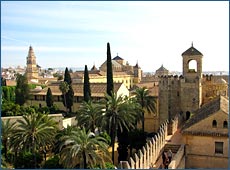|
|
|
|
 |
|
| |
| » |
Barcelona's Sagrada Familia |
» |
Feria de Abril, Seville |
| » |
Prado Museum, Madrid |
» |
Picos de Europa |
| » |
Alhambra Palace – Granada |
» |
Balearic Islands |
| » |
Guggenheim Museum Bilbao |
» |
Cordoba and the Mezquita |
| » |
La Tomatina Festival, Buñol |
» |
Toledo |
|
|
|
 |
| |
| The Cordoba Mezquita is dated back to the 10th century when Córdoba reached its zenith under a new emir, Abd ar-Rahman 111 who was one of the great rulers of Islamic history. At this time Córdoba was one of the largest, most prosperous cities of Europe, outshining Byzantium and Baghdad in science, culture and the arts. The development of the Great Mosque paralleled these new heights of splendor. |
| |
| Today the Cordoba de la Mezquita as it is known can be visited throughout the year for 6 Euro entrance fee. The approach is via the Patio de los Naranjos, a classic Islamic ablutions courtyard which preserves both its orange trees and fountains. When the mosque was used for Moslem prayer, all nineteen naves were open to this courtyard allowing the rows of interior columns to appear like an extension of the tree with brilliant shafts of sunlight filtering through. |
| |
| The most lavish interior ornament is concentrated in the maqsura, the prayer space reserved for the ruler, which was commissioned by the caliph al-Hakam II. The maqsura is visually separated from the rest of the prayer hall by screens formed of elaborate intersecting polylobed arcades, an elegant variation on the basic architectural theme set in the earliest incarnation of the mosque. These screens emphasize the special status of the space, which is composed of three domed bays in front of the mihrab. The mihrab at Cordoba la Mezquita was unprecedented for taking the form of an entire room rather than the traditional niche, and for being flanked by two rooms whose entrances are decorated with mosaics in a manner similar to that of the mihrab. The maqsura is lavishly decorated with carved marble, stucco, and elaborate mosaics. These, executed in intricate vegetal scroll forms and Kufic inscriptions, frame the mihrab, the two doors which flank it, and also cover the interiors of the maqsura's three domes. The unusual arrangement of the maqsura space may be read on several levels. |
| |
|
|
|



